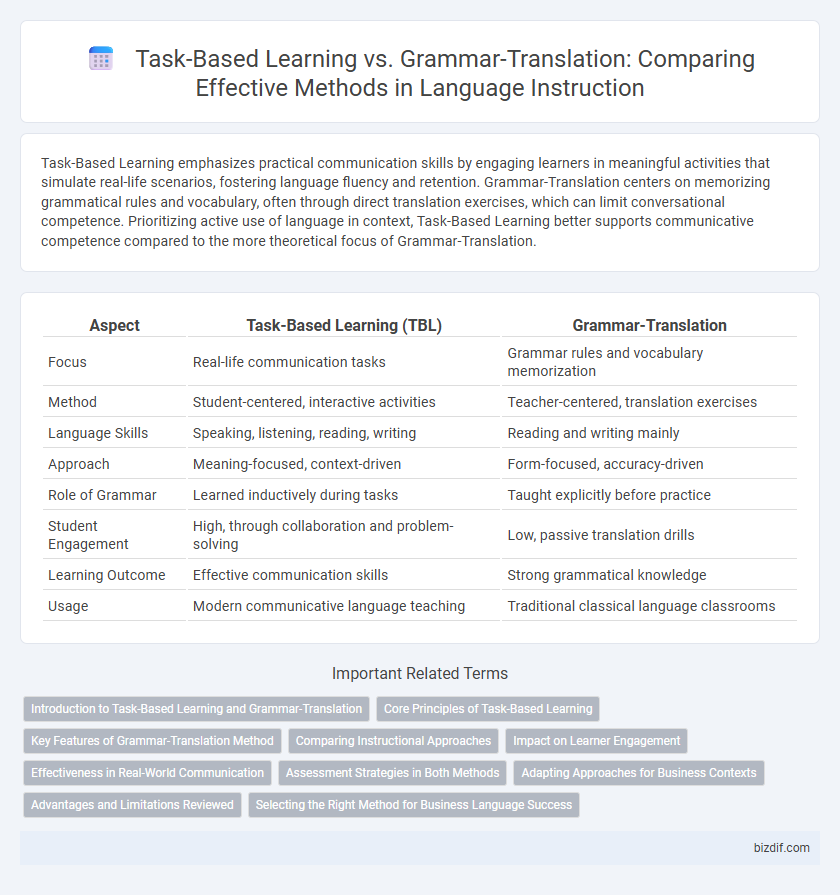Task-Based Learning emphasizes practical communication skills by engaging learners in meaningful activities that simulate real-life scenarios, fostering language fluency and retention. Grammar-Translation centers on memorizing grammatical rules and vocabulary, often through direct translation exercises, which can limit conversational competence. Prioritizing active use of language in context, Task-Based Learning better supports communicative competence compared to the more theoretical focus of Grammar-Translation.
Table of Comparison
| Aspect | Task-Based Learning (TBL) | Grammar-Translation |
|---|---|---|
| Focus | Real-life communication tasks | Grammar rules and vocabulary memorization |
| Method | Student-centered, interactive activities | Teacher-centered, translation exercises |
| Language Skills | Speaking, listening, reading, writing | Reading and writing mainly |
| Approach | Meaning-focused, context-driven | Form-focused, accuracy-driven |
| Role of Grammar | Learned inductively during tasks | Taught explicitly before practice |
| Student Engagement | High, through collaboration and problem-solving | Low, passive translation drills |
| Learning Outcome | Effective communication skills | Strong grammatical knowledge |
| Usage | Modern communicative language teaching | Traditional classical language classrooms |
Introduction to Task-Based Learning and Grammar-Translation
Task-Based Learning emphasizes real-life communication and practical task completion to enhance language acquisition, encouraging learners to use language actively in meaningful contexts. Grammar-Translation focuses on the explicit teaching of grammatical rules and vocabulary through translation exercises, often prioritizing written language over spoken fluency. Task-Based Learning promotes interactive, student-centered activities, whereas Grammar-Translation is more teacher-centered and relies heavily on memorization and direct instruction.
Core Principles of Task-Based Learning
Task-Based Learning centers on using authentic language tasks to promote practical communication skills, emphasizing meaning over form. It prioritizes learner engagement through real-world activities that require problem-solving and interaction, fostering natural language acquisition. This approach contrasts with Grammar-Translation by focusing on fluency and contextual use rather than rote memorization of grammatical rules.
Key Features of Grammar-Translation Method
The Grammar-Translation Method emphasizes the explicit teaching of grammatical rules and vocabulary through direct translation between the target language and the native language. It relies heavily on reading and writing exercises, with limited focus on speaking and listening skills. This method prioritizes accuracy, rote memorization, and the ability to analyze language structures over communicative competence.
Comparing Instructional Approaches
Task-Based Learning emphasizes practical communication and real-world language use through interactive tasks, promoting fluency and contextual understanding. Grammar-Translation relies on memorization of grammatical rules and vocabulary with a focus on reading and writing accuracy, often neglecting speaking and listening skills. Comparing instructional approaches reveals Task-Based Learning enhances communicative competence, while Grammar-Translation benefits learners requiring detailed grammatical knowledge.
Impact on Learner Engagement
Task-Based Learning enhances learner engagement by focusing on real-life communication tasks that promote active participation and practical language use. In contrast, Grammar-Translation often results in passive learning, emphasizing memorization of rules and translations with limited interaction. Studies indicate that Task-Based Learning cultivates higher motivation and sustained attention, leading to improved language retention and application.
Effectiveness in Real-World Communication
Task-Based Learning enhances real-world communication by prioritizing meaningful interaction and practical language use over rote memorization. Grammar-Translation emphasizes accuracy and structural knowledge but often lacks opportunities for spontaneous speaking and listening practice. Studies show learners engaged in Task-Based Learning develop stronger conversational skills and higher communicative competence in authentic contexts.
Assessment Strategies in Both Methods
Task-Based Learning assessment emphasizes real-world language use through performance-based tasks, promoting communicative competence and practical problem-solving skills. Grammar-Translation assessment focuses on accuracy in grammatical rules and vocabulary through written tests, translations, and error correction exercises, prioritizing linguistic knowledge over fluency. Both methods offer distinct evaluation approaches, with Task-Based Learning favoring dynamic, interactive assessments while Grammar-Translation relies on traditional, form-focused testing.
Adapting Approaches for Business Contexts
Task-Based Learning enhances practical communication skills by engaging learners in real-world business scenarios, promoting fluency and adaptability. Grammar-Translation emphasizes linguistic accuracy and vocabulary through direct translation exercises, which may limit spontaneous business interactions. Adapting these approaches involves integrating task-based activities for communicative competence while retaining grammar-focused drills to ensure precise language use in professional settings.
Advantages and Limitations Reviewed
Task-Based Learning enhances communicative competence by engaging learners in real-life tasks, promoting practical language use and fluency development. Grammar-Translation excels in building strong grammatical knowledge and vocabulary through systematic translation exercises but often limits speaking and listening skills. Both methods exhibit advantages and limitations, with Task-Based Learning improving interactive skills while Grammar-Translation provides clear structural understanding, making a combined approach beneficial.
Selecting the Right Method for Business Language Success
Task-Based Learning enhances business language success by promoting practical communication skills through real-world tasks, enabling learners to navigate workplace scenarios effectively. In contrast, Grammar-Translation emphasizes rote memorization of rules and vocabulary, which may limit fluency and spontaneous use in business contexts. Selecting Task-Based Learning aligns better with developing functional language proficiency needed for dynamic business interactions.
Task-Based Learning vs Grammar-Translation Infographic

 bizdif.com
bizdif.com